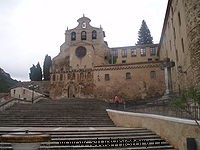The origins of the County of Castile date back to an administrative division of the Astur-Leonese kingdom that emerged in the 8th century after the Arab conquest of the Peninsula. The county was originally located in the area of Bardulia (to the north of the province of Burgos), so called by the tribe of the bardules that inhabited it; The first Castilian count was appointed back in the year 860 by King Ordoño II and his name was Rodrigo.
The county was gaining a certain independence from the Leonese kingdom based on the political and military ups and downs of the region. The figure of what is considered the first independent count of Castile, Fernán González, stands between history and legend. It narrates that, when King Sancho I of León fell in love with a goshawk and a horse owned by the Castilian count, he ceded them to him in exchange for the monarch's promise to pay a small price later that would increase with each passing day. When, years later, the king agreed, it was time to make the payment, the debt was so enormous that the king had no choice but to cede the county to Fernán. The beginning of his rule is placed around the year 930 and he died in 970.
Beyond this legendary story, and although it is not the main objective of this entry, suffice it to say that the gradual independence of the increasingly strong Castilian county was based on the divisions and dynastic and military difficulties of the Leonese kingdom and the changing set of alliances between the peninsular domains, both Christian and Muslim. It was not so much that Fernán González was the first independent count of Castile as that he managed to unify different territories as part of Castile and establish the Castilian county as a decisive force in setting the policies of the Leonese kingdom, managing to place his son-in-law Ordoño IV on the Leonese throne. Additionally, thanks to this predominant position, he was finally able to take the step of linking the succession of the Castilian county to his own lineage and not to the appointment decided by the Leonese monarch on duty.
Thus, Fernán González was succeeded by his son García Fernández, that of this Sancho García and that of the latter, the protagonist of our story García Sánchez (the custom of that the children would not inherit their father's surname, but rather take his own name as their surname).
The historical data that has reached us about the figure of García Sánchez is not many. When his father died in 1017, the new count was a minor (about seven years old), so the county was placed under the regency of his aunt Urraca and a council of notables. Alfonso V reigned in León and Sancho III in Pamplona, married to the sister of the new Castilian count, named Munia (or Mayor).
The Castilian county, although powerful and extensive, was not exempt from territorial conflicts with its neighboring kingdoms, both to the west (León) and to the east (Pamplona) and did not contribute to its stability the minority of age of the new count. As Sancho approached the age of majority, it became necessary to look for a wife for him and the natural candidate was the Leonese princess Sancha, daughter of Alfonso V. She would contribute as a dowry the lands located between the Cea and the Pisuerga, thus putting an end to the conflict between Castilla and León for them.
The marriage was to become effective in 1028 when García came of age, but in that year several events occurred that made it never take effect. In the first place, the Leonese king Alfonso V died in the siege of Viseo, so the throne passed to his son Bermudo III, who, like the Castilian count before, was a minor. Despite this, it was decided to go ahead with the link, so the count set off from Burgos to León in a retinue that included his brother-in-law, Sancho III of Pamplona.
But when the groom was already in León preparing for the betrothal, he passed away under mysterious circumstances. The first source that mentions the murder hypothesis is the Najerense Chronicle, from the second half of the 12th century (that is, more than a hundred years after the count's death). Subsequently, other sources speak of the murder of García Sánchez and point to the Vela family from Alava as being responsible for it. The Romanz chanson de geste of the Infant García and the Velas underpinned this thesis and influenced the fact that García Sánchez was avenged by his brother-in-law Sancho III of Pamplona, who besieged the Velas in his castle and killed them.
Subsequently, other authors, pointing to the well-known principle according to which in order to know the perpetrator of a crime, one must ask who is taking advantage of it, opt for considering that behind the death from García Sancho III of Pamplona could be found. It is true that the death of the Castilian count resulted in the king of Pamplona, through his wife Munia (Garcia's sister), taking control of the Castilian county, but there is no historical evidence whatsoever that García Sánchez was assassinated or , if so, of the involvement of the Navarrese in the death of his brother-in-law.

Whatever the cause of Garcia's death Sánchez and who was responsible for it, what is certain is that his death put an end to the lineage of Fernán González as counts of Castile. The son of Sancho III of Pamplona Fernando, would go down in history as Fernando I el Magno and would end up dividing the kingdom between his sons Sancho (whom he gave Castile) and Alfonso (whom he gave León), who is known as Alfonso VI and that Toledo recovered in 1085... but that's another story.
New Bardulia
County of Castile
